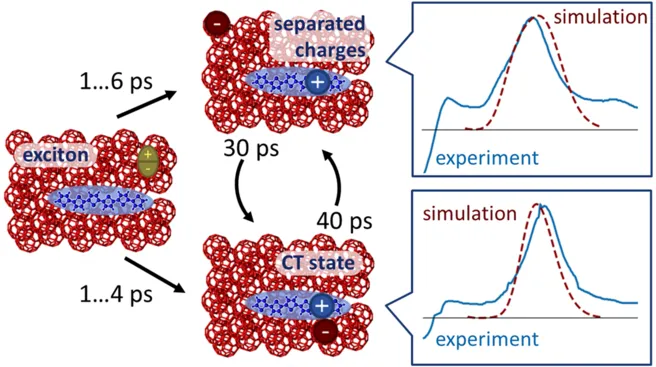The groundbreaking findings, published in Nature Communications, could significantly advance the development of efficient organic photovoltaic technologies.
The Challenge of Charge Separation
Despite remarkable progress in organic solar cells, the precise dynamics of charge generation and separation had remained unclear. By employing transient absorption spectroscopy and extensive simulations based on time-dependent density functional theory, the team has managed to spectrally distinguish between CTCs and separated charges, thereby tracing their dynamic evolution. This direct visualization opens new avenues for optimizing organic solar cells.
“These findings represent a major breakthrough, as we now better understand the mechanisms of charge separation in organic solar cells,” explains Prof. Banerji. “This could be the key to developing more sustainable and high-performance solar cells.”
New Insights into Functionality
The study reveals that separated charges are formed via two pathways: either directly within a few picoseconds from excitons or more slowly (around 30 picoseconds) through the reversible splitting of CTCs. This discovery resolves a long-standing controversy in the field and demonstrates that both mechanisms can simultaneously contribute to photocurrent generation.
Commercial and Scientific Relevance
The findings are particularly significant for thermally evaporated organic solar cells, a leading technology. Additionally, the study provides insights for optimizing modern materials, such as non-fullerene acceptors (NFAs), which enable high efficiencies exceeding 18%. “Our results provide new perspectives for improving the efficiency of organic solar cells and their application potential,” says Prof. Ortmann, co-author of the study.
A Collaborative Effort
The research brought together expertise in physics, chemistry and materials science, with contributions from such institutions as the University of Bern (Switzerland), the Technical University of Dresden, the University of Oxford (UK), and the Universidade de São Paulo (Brazil). The project was supported by national and international research programs, including the German Research Foundation (Cluster of Excellence e-conversion).
Publication in Nature Communications: “Direct visualization of the charge transfer state dynamics in dilute-donor organic photovoltaic blends” (DOI: doi.org/10.1038/s41467-024-53694-4)
Further information and links:
- Prof. Frank Ortmann (Professor for Theoretical Methods in Spectroscopy)
- Prof. Natalie Banerji at the University of Bern(FemtoMat Research Group)
- Cluster of Excellence e-conversion
Presse contact:

